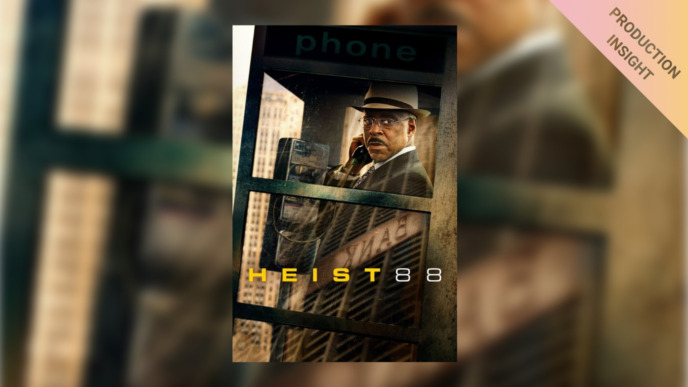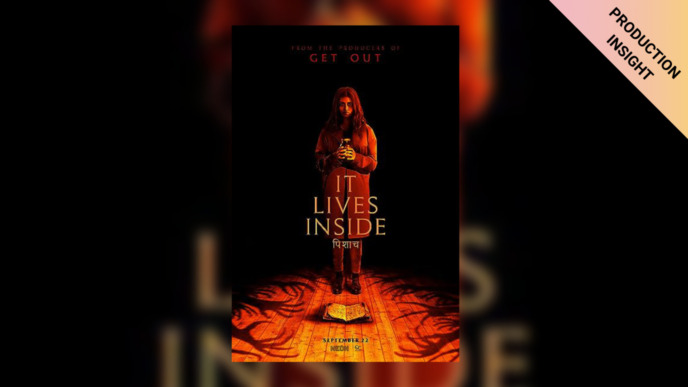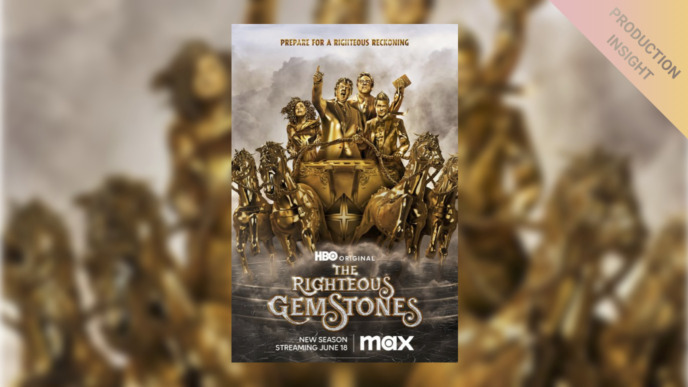
The director is working at full speed, and new creative ideas pop up constantly on set while filming is already in full swing? This can quickly become a mess as every team has to react to new instructions on pretty short notice.
In such a case, it is helpful if at least DP and DIT are a well-rehearsed team and can bring the anticipated look to the monitors in no time using adequate software.
In this interview, DIT Gastone Ferrante lets us know how the collaboration between DP Alan Stewart and himself actually worked out on set of Guy Ritchie’s latest movie, Wrath of Man.
In addition to Silverstack Lab, Livegrade Pro was also an integral part of his work, which even the make-up department could benefit from.
First of all, thank you for sharing some insights into your productions with us. Can you tell us a bit about yourself and your work first?
Thank you for inviting me. I’m Italian and based in London. My career in film production started as a stills photographer’s assistant. After a few years of photography, I studied editing in Cinecittà and started working as an editor in Rome. I mostly did documentaries and short films, but I soon realized I wanted to work on feature films. What I liked most about editing was the technology and the thorough organization underpinning the process. While working as an editor, I often spent all my spare time playing with DI software and grading shorts. So, about the same time the RED One came out, I decided to leave editing, and I started my collaboration with some DIT friends, first as a Data Manager and then as a DIT.

What kind of projects are you usually working on?
I usually work on feature films and commercials, but since I moved to the UK (about five years ago), I’ve focused mostly on major motion pictures. I’m quite intrigued by the challenges those projects provide. To mention one, I was one of the first DITs able to work with a dual-color pipeline (SDR and HDR) on set for Disney’s Cruella.
You recently worked on a production called Wrath of Man. Can you tell us a bit about this project? How did the team come together and what role did you play?
After moving to the UK, I started working as a DIT with Alan Stewart, the Cinematographer on Wrath of Man. I met him on the Second Unit of Mary Poppins Returns, and since then, I have been one of his close collaborators. Starting with Aladdin, we have shot four of Guy Ritchie’s movies so far, with some other directors’ projects in between. I consider the camera team Alan managed to put together more like a family than colleagues. They helped me integrate into this country. We were all offered Cash Truck (the project’s name during production) while we were finishing the Principal Photography of Warner Brother’s Tom & Jerry. It was a smaller budget production written while we were still shooting Guy’s The Gentleman.

Guy shoots in a very peculiar way. Most of the time, he will rewrite and review his own script on set, right up until we’ll turn the cameras. You can see his creative process happening while he builds the scene with the actors and the cameras as we go. It’s a very interesting experience but also quite stressful as he’s usually very impatient. Especially when he’s excited about what he just wrote. He starts counting down “going in 5, going in 4…”. When his crew hears that, they know they have to drop everything they are doing and rehearse/shoot on camera so he can see what the result is and tweak it to reach what he wants. You can see electricians hugging lights to keep them in place for the take, actors with only half of their make-up done, crew lying down on the floor as they have been caught out, and they realize they won’t be able to get out of the shot in time. It’s hilarious and stressful at the same time. Due to Alan’s good understanding of Guy’s mental process, as well as his Scottish composure, he’s been able to facilitate this way of shooting while also keeping everybody’s nerves low. After its performance at the box office and with Miramax being happy with the aesthetics of The Gentleman, Alan earned his place on Wrath of Man, and all of us followed. I usually take care of designing the color pipeline, as well as maintaining its consistency between set and post-production. I’m responsible for setting and pulling the iris on each camera to expose the image properly. I help Alan and his gaffer light the scene, providing them with observations and suggestions on color temperatures and light intensities. I live grade on set, trying to get as close as possible to the final look Alan wants to achieve and pass that look down the line. I supervise the Data Manager’s work and the workflow from start to finish making sure VFX, post-production, and editorial are getting everything they need and are working with the right framing and look. Most of my hard work happens during pre-production and the camera tests, but undoubtedly there will be sudden out the box requests that I’m more than happy to facilitate during production. I’m a handyman.

Which cameras were used on this project?
Our main cameras were Sony VENICEs. We also had some Sony A7 MK2s and RXOs. I really appreciate the fact Alan trusts me a lot, especially when it comes to selecting the right camera for the job. During pre-production, he wants me to advise on any possible camera solution for the needs of the project, as well as test them to try and get the most out of them. Tom & Jerry was the first project we used the Venice on. The camera and lenses went through a thorough testing process. Some of the useful functions of the latest Sony Venice firmware come from suggestions we made during our initial testing. Others we asked Sony engineers to develop specifically for Wrath of Man.

You’ve worked with Silverstack Lab and Livegrade Pro on Wrath of Man. How was this decision made? Were there specific requirements for the use of both applications?
I’m a long-time user of Pomfort products. I really appreciate the simplicity and flexibility of the toolset provided by both Livegrade and Silverstack. I also love how well the Pomfort team reacts to new suggestions and feature requests. Sometimes it might take a while, but if they are sensible features, rest assured they are going to be there eventually. Livegrade is my go-to for live grading on set since the other software I was using was discontinued. On Wrath of Man, I wasn’t able to have my full team with me (I usually work with a data manager and an assistant on the floor), but just an assistant that had to fulfill both roles. For that reason, I needed to use a simple and effective workflow. This would also prove helpful for the American part of the production as I couldn’t join it, so I had to rely on the help of two colleagues over there. Keeping it simple but still having all the tools to achieve the end result was key and my prerogative. The combination and integration of the two software applications provided me exactly that. Livegrade allowed me to apply the custom transforms I needed to properly match the ACES pipeline Peter Doyle, our Colorist, would have used in Baselight during the DI process. Silverstack Lab made metadata editing and the CDL relinking process quick and easy while still allowing me to replicate the color pipeline used on set and to grab reference stills from the offloaded footage with that color pipeline applied.

On top of that, keeping everything in the same software (or family of software) helps a lot when you’re shooting with multiple cameras, different formats, and reduced crew. From my perspective, the difference between a poor and a properly prepared film is huge, especially when it comes to having the right tools and making everything work on set. Knowing your tools in advance gives you confidence and the freedom of concentrating your efforts on using your creativity to serve the film in the best possible way instead of troubleshooting issues due to your poor knowledge of the tool itself. I knew the Pomfort tools well, and I chose them as it was one less thing I had to think about.

Could you please describe one ‘typical’ shooting day on this production?
Oh lord, there is no typical day on set as far as I’m concerned. They are all different but at the same time all very similar. You start the day trying to understand where to set up your tent to cover the majority of the scene without being in the shot but still allowing the DoP to be as close as possible to the set. Alan is in love with the tent. I think being able to see what the result will look like makes him work better as he can adjust the light better and realize straight away if something does or doesn’t work. So my biggest concern during the day is to provide him with pictures on the monitors and make sure the cameras are running as expected. That’s obviously on top of all the tasks I’ve described before. On this particular project, we had loads of “security cameras”, especially at the Fortico headquarters. There were some scenes where I was feeding all the security monitors (about 6 or 8) with the live feed from the security cameras (6 cameras between A7s and RXOs) as Alan wanted to avoid using green screens for the security monitors. I was even applying a security camera kind of look to the picture and creating a quad split on the monitors, all in real-time while shooting the scene. These were busy days. It took quite a lot of planning to achieve the final result, which I think came out great. However, there is always time for a good laugh with the camera, grip, and electrical departments, even when it’s a busy and stressful day. Sometimes film sets are super serious, and the crew is so focused, thinking they are saving the world. I guess we are somehow, but we’re not performing brain surgery. We could work in a much more relaxed way, but this concept often gets lost. I know everybody wants to do their best. In the end, most of the people that work in this industry are doing it for the love of the art, but there should be a limit. We’re not saving lives, at least not directly.


How was your overall experience with Silverstack Lab and Livegrade Pro like? Were there any features that you used frequently, or liked in particular?
Livegrade has a lot more to offer than I ask of it. There are functions I don’t use, like still grabs, video recording, the library slot, and metadata editing. I even export the CDLs as multiple CDL files and tell my Data Manager verbally which one to apply to which take instead of linking them with timecode and exporting a look archive. On the other hand, I really love the Freestyle modes (I was one of the users pushing to have the feature implemented), the integration with video routers like the AJA Kumo, and the editable shortcuts. Last but not least is the internal video range scaling. If this feature weren’t there, working with the Venice would have been a nightmare as the camera’s output is full range, but most of the monitors on set are legal range, and any LUT box I know of can’t deal with mixed ranges. Silverstack has always been a great tool for on-set backups, but its library is also great. Some of the features I’ve used most on this project are the metadata editing, the ALE+CDL export, the shooting day and clip reports, and, to rule them all, the reference stills export feature. I’m eagerly awaiting ProRes RAW support, and my Data Manager is regularly back and forth with product support about minor bugs, but overall the products are great.

How does on-set grading influence the work of the DP? Can Livegrade help with creative decisions?
As I mentioned before, I think live grading on set is a great tool, not just for the DoP. All departments can take advantage of the fact that the image can be as close as possible to the final result. The Director can show up and ask to check how a particular shot will look if it’s taken in a cold direction instead of a warm one. The DoP doesn’t have to worry if the zoom on camera B is greener or lower in contrast than your main set of primes. The make-up department can see on set if the creative grade of the DoP will make their actors look too red and make adjustments accordingly. Producers can sleep better knowing what they are seeing is what they’ll get.
Were there any particularly challenging situations or setups on this project?
The small cameras are always challenging to deal with, especially since they are almost always prosumer or even consumer cameras that aren’t suited to production use. You have to find creative solutions to integrate them into your color pipeline and workflow. I already mentioned the security cameras. That was surely the most challenging part of the whole job. Even just setting them up was painful, let alone the color management. But we’re all doing this job for the challenge!
When you think back to Wrath of Man, what is your most memorable experience? What did you enjoy the most?
The laughs on set with Alan and the camera department and the Sunday roasts with my friends after a hard week of work – those were the times when we could still meet and see each other’s faces without standing meters apart.

____________________________
Big ‘Thank You’ to Gastone for letting us be part of this exciting project!
Gastone Ferrante, DIT
Gastone is a London-based DIT who mainly works on feature films. Being from Italy, he started his career in the movie business in Rome as an editor but eventually found his way to working as a DIT full time. Wrath of Man has already been the fourth of Guy Ritchie’s movies, which Gastone was part of (The Gentlemen, Aladdin, King Arthur: Legend of the Sword).



